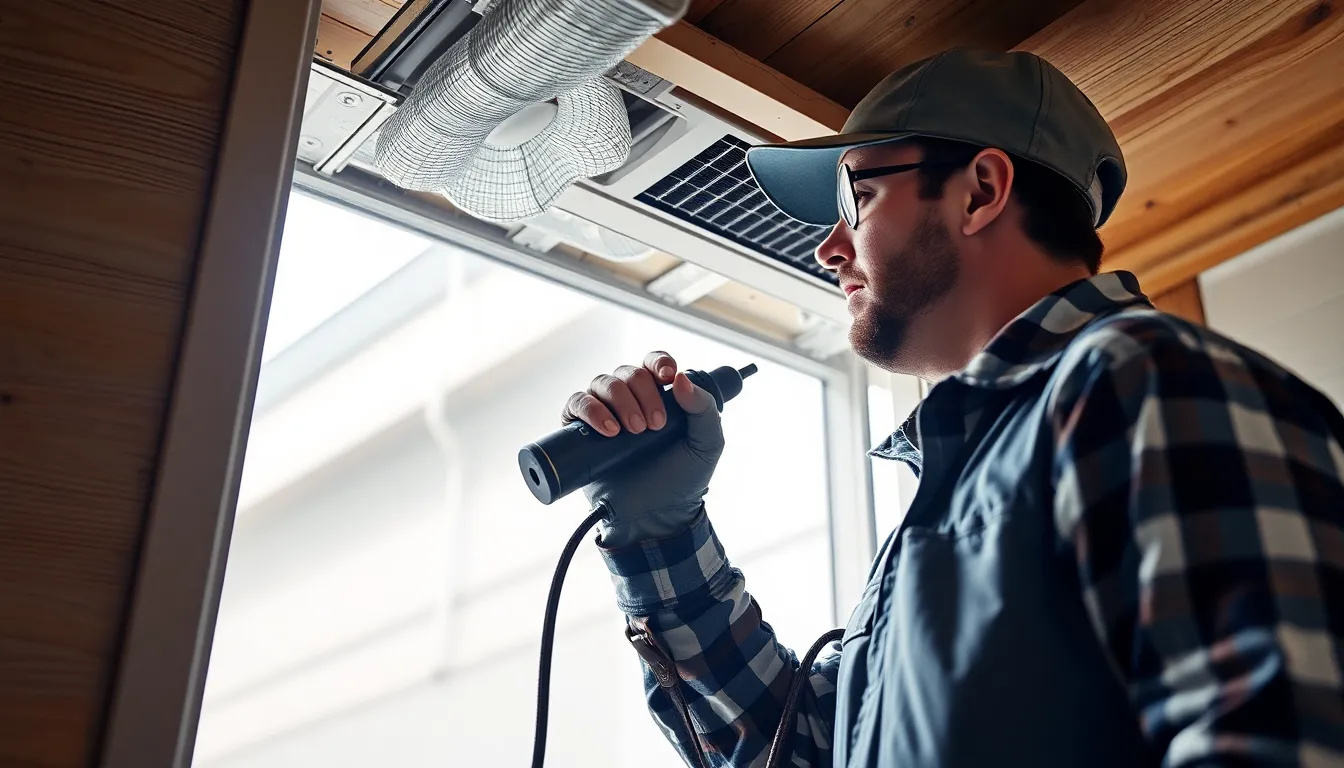Air duct sealing plays a crucial role in maintaining a home’s energy efficiency and indoor air quality. Over time, ducts can develop leaks, allowing conditioned air to escape and increasing energy bills. Homeowners often overlook this essential aspect of HVAC maintenance, but addressing it can lead to significant savings and a more comfortable living environment.
By sealing air ducts, families can enjoy improved airflow and reduced energy consumption. This simple yet effective solution not only enhances comfort but also contributes to a healthier home. Understanding the importance of air duct sealing empowers homeowners to make informed decisions about their HVAC systems and overall energy usage.
Table of Contents
ToggleOverview Of Air Duct Sealing
Air duct sealing involves identifying and repairing leaks in the ductwork system. It plays a crucial role in enhancing energy efficiency and ensuring optimal performance of heating, ventilation, and air conditioning (HVAC) systems.
Air leaks can occur at joints, seams, or any unsealed areas within ducts. Products such as mastic sealants, foil tape, and duct insulation address these leaks effectively. Proper sealing prevents conditioned air from escaping into unoccupied spaces, which directly lowers energy bills while improving airflow throughout the home.
Studies indicate that up to 30% of conditioned air can be lost through leaky ducts. This loss can significantly impact heating and cooling efficiency, resulting in increased operational costs. By sealing air ducts, homeowners not only save money but also enhance indoor air quality by minimizing dust, allergens, and pollutants circulating in the living environment.
Regular inspections and maintenance of air ducts are recommended. Professional technicians can effectively assess the integrity of duct systems, utilizing tools like infrared cameras and pressure tests. Addressing any identified issues promptly supports long-term energy savings and a healthier home atmosphere.
Benefits Of Air Duct Sealing

Air duct sealing offers significant advantages in energy efficiency and indoor air quality. Addressing leaks leads to a more comfortable home while lowering energy costs.
Improved Energy Efficiency
Improved energy efficiency results directly from sealing leaks in air ducts. Leaks can lead to the loss of up to 30% of conditioned air, causing heating and cooling systems to work harder to maintain desired temperatures. Sealing ducts ensures that the conditioned air reaches intended spaces, reducing energy consumption and lowering utility bills. Homeowners can expect more consistent temperatures and decreased wear on HVAC systems, prolonging their lifespan and enhancing overall performance.
Enhanced Indoor Air Quality
Enhanced indoor air quality follows effective air duct sealing. Sealed ducts minimize the infiltration of dust, allergens, and pollutants from unconditioned spaces. These contaminants can accumulate in ductwork, negatively impacting health. By sealing air ducts, homeowners reduce exposure to respiratory irritants, leading to a healthier living environment. Regular maintenance and sealing also support better airflow, allowing HVAC systems to effectively filter indoor air.
Common Issues With Air Ducts
Air ducts can experience a variety of problems that impact their efficiency and effectiveness. Proper attention to these issues ensures optimal performance of HVAC systems and enhances indoor air quality.
Leaks and Gaps
Leaks and gaps in air ducts can lead to significant energy loss. Ductwork can develop leaks at joints, seams, or where ducts connect to vents and registers. Studies reveal that up to 30% of conditioned air escapes through these gaps, driving up energy bills. Homeowners should consider sealing any visible leaks with mastic sealants or foil tape. Regular inspections conducted by professional technicians help identify hidden leaks, ensuring efficient air distribution throughout the home.
Poor Insulation
Poor insulation negatively affects the efficiency of air ducts. Insufficient insulation creates temperature fluctuations, causing ducts to lose or gain heat as air travels through them, ultimately impacting overall comfort levels. Insulating ducts in unconditioned spaces, such as attics or crawl spaces, prevents energy waste by maintaining the desired temperature of the air within the ducts. Insulation materials, such as fiberglass or foam, effectively minimize heat transfer, contributing to improved energy efficiency and consistent indoor temperatures. Homeowners should evaluate duct insulation during routine maintenance to optimize their HVAC systems’ performance.
Methods Of Air Duct Sealing
Air duct sealing employs various effective methods to enhance system efficiency and improve indoor air quality by eliminating leaks. Two prominent techniques include mastic sealant and Aeroseal technology.
Mastic Sealant
Mastic sealant serves as a popular choice for sealing air ducts. This thick, paste-like compound adheres to metal and duct materials, creating a durable barrier against air leaks. Applications of mastic happen at joints, seams, and connections, ensuring a strong hold. Once applied, mastic dries to form a robust seal that withstands temperature fluctuations and maintains flexibility over time. This method is particularly effective in reducing air loss, which can contribute to energy savings of approximately 10% to 20%. Proper application of mastic requires a clean surface and may take several hours to cure fully, making it essential to plan service times accordingly.
Aeroseal Technology
Aeroseal technology represents a modern approach to air duct sealing. This innovative method involves introducing a polymer-based aerosol sealant into the ductwork. The sealant travels through the system, finding and sealing leaks as it expands upon contact with surfaces. Aeroseal can seal holes and gaps of up to 1 inch in diameter, providing comprehensive coverage throughout the duct system. This technique offers a significant advantage, as it requires minimal labor and insulation disruption, ensuring quick and efficient service. Studies show that Aeroseal can reduce air leakage by up to 90%, thereby improving HVAC efficiency and indoor air quality. Due to its effectiveness and ease of use, Aeroseal is gaining popularity among homeowners seeking long-term solutions to air duct leakage.
Choosing A Professional Service
Selecting a professional service for air duct sealing involves several key considerations. Evaluating experience matters, as established companies bring a wealth of expertise to the task. Checking credentials helps ensure technicians possess relevant certifications and training in HVAC systems.
Reviewing customer feedback is crucial. Positive reviews indicate reliability and quality. Searching for testimonials or case studies provides insight into the service quality homeowners can expect.
Requesting quotes from multiple service providers allows for comparison. Understanding price ranges encourages informed decisions while ensuring the chosen service fits within budget constraints.
Inquiring about specific sealing methods offers clarity on the expertise of a company. Familiarity with modern techniques like mastic sealant and Aeroseal technology demonstrates a commitment to effective solutions.
Confirming warranties on work performed is important. Reliable services often guarantee their work, which provides peace of mind for homeowners.
Assessing the availability of ongoing maintenance services is beneficial. Continuous support can keep ducts in optimal condition and prevent future issues.
Ensuring that the service provider offers thorough inspections enhances the sealing process. Comprehensive assessments identify all potential leaks, maximizing energy efficiency and indoor air quality benefits.
Considering these factors enables homeowners to choose a competent, reputable service dedicated to providing effective air duct sealing solutions.
Air duct sealing is a vital step for homeowners seeking to boost energy efficiency and improve indoor air quality. By effectively sealing leaks and ensuring that conditioned air reaches its intended destination, homeowners can enjoy lower utility bills and a more comfortable living environment. Utilizing modern sealing methods like mastic sealant and Aeroseal technology provides reliable solutions for addressing duct issues with minimal disruption.
Choosing a qualified professional for air duct sealing not only ensures proper application but also maximizes the benefits of this essential maintenance task. With regular inspections and timely repairs, homeowners can maintain the integrity of their HVAC systems while enjoying a healthier and more efficient home.


